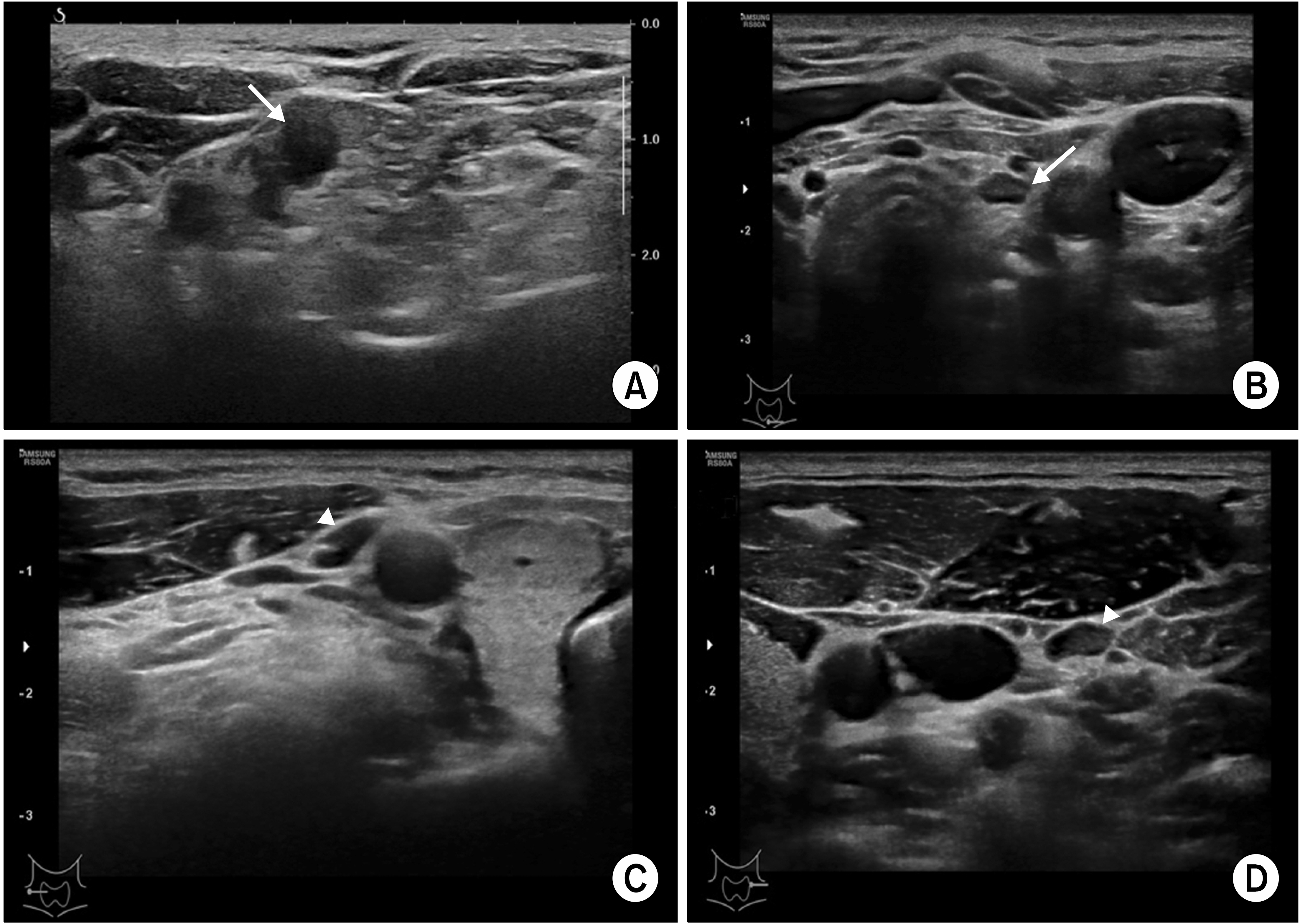1. DeGroot LJ, Kaplan EL, McCormick M, Straus FH. 1990; Natural history, treatment, and course of papillary thyroid carcinoma. J Clin Endocrinol Metab. 71:414–24. DOI:
10.1210/jcem-71-2-414. PMID:
2380337.

2. Rovira A, Nixon IJ, Simo R. 2019; Papillary microcarcinoma of the thyroid gland: current controversies and management. Curr Opin Otolaryngol Head Neck Surg. 27:110–6. DOI:
10.1097/MOO.0000000000000520. PMID:
30844924.
3. Davies L, Welch HG. 2006; Increasing incidence of thyroid cancer in the United States, 1973-2002. JAMA. 295:2164–7. DOI:
10.1001/jama.295.18.2164. PMID:
16684987.

4. Ho AS, Chen I, Melany M, Sacks WL. 2018; Evolving management considerations in active surveillance for micropapillary thyroid carcinoma. Curr Opin Endocrinol Diabetes Obes. 25:353–9. DOI:
10.1097/MED.0000000000000438. PMID:
30153222.

5. Sun H, Dionigi G. 2018; Active surveillance for micro-papillary thyroid carcinoma: who are candidates, how should they be followed, when should they be treated, and what are the clinical and pathologic outcomes after delayed intervention. Surgery. 163:1325–9. DOI:
10.1016/j.surg.2017.12.032. PMID:
29398034.

6. Vasileiadis I, Boutzios G, Karalaki M, Misiakos E, Karatzas T. 2018; Papillary thyroid carcinoma of the isthmus: total thyroidectomy or isthmusectomy? Am J Surg. 216:135–9. DOI:
10.1016/j.amjsurg.2017.09.008. PMID:
28954712.

7. Filetti S, Durante C, Hartl D, Leboulleux S, Locati LD, Newbold K, et al. 2019; Thyroid cancer: ESMO clinical practice guidelines for diagnosis, treatment and follow-up
†. Ann Oncol. 30:1856–83. DOI:
10.1093/annonc/mdz400. PMID:
31549998.
8. Bergdorf K, Ferguson DC, Mehrad M, Ely K, Stricker T, Weiss VL. 2019; Papillary thyroid carcinoma behavior: clues in the tumor microenvironment. Endocr Relat Cancer. 26:601–14. DOI:
10.1530/ERC-19-0074. PMID:
30965283.

9. Haugen BR, Alexander EK, Bible KC, Doherty GM, Mandel SJ, Nikiforov YE, et al. 2016; 2015 American Thyroid Association management guidelines for adult patients with thyroid nodules and differentiated thyroid cancer: the American Thyroid Associa-tion guidelines task force on thyroid nodules and differentiated thyroid cancer. Thyroid. 26:1–133. DOI:
10.1089/thy.2015.0020. PMID:
26462967. PMCID:
PMC4739132.

10. Haugen BR. 2017; 2015 American Thyroid Association Management guidelines for adult patients with thyroid nodules and differentiated thyroid cancer: what is new and what has changed? Cancer. 123:372–81. DOI:
10.1002/cncr.30360. PMID:
27741354.

12. Remonti LR, Kramer CK, Leitão CB, Pinto LC, Gross JL. 2015; Thyroid ultrasound features and risk of carcinoma: a systematic review and meta-analysis of observational studies. Thyroid. 25:538–50. DOI:
10.1089/thy.2014.0353. PMID:
25747526. PMCID:
PMC4447137.

13. Grant EG, Tessler FN, Hoang JK, Langer JE, Beland MD, Berland LL, et al. 2015; Thyroid ultrasound reporting lexicon: white paper of the ACR Thyroid Imaging, Reporting and Data System (TIRADS) committee. J Am Coll Radiol. 12(12 Pt A):1272–9. DOI:
10.1016/j.jacr.2015.07.011. PMID:
26419308.
14. Oh HS, Ha J, Kim HI, Kim TH, Kim WG, Lim DJ, et al. 2018; Active surveillance of low-risk papillary thyroid microcarcinoma: a multi-center cohort study in Korea. Thyroid. 28:1587–94. DOI:
10.1089/thy.2018.0263. PMID:
30226447.

15. Zanocco KA, Hershman JM, Leung AM. 2019; Active surveillance of low-risk thyroid cancer. JAMA. 321:2020–1. DOI:
10.1001/jama.2019.5350. PMID:
31038662.

17. Van Holsbeke C, Daemen A, Yazbek J, Holland TK, Bourne T, Mesens T, et al. 2009; Ultrasound methods to distinguish between malignant and benign adnexal masses in the hands of examiners with different levels of experience. Ultrasound Obstet Gynecol. 34:454–61. DOI:
10.1002/uog.6443. PMID:
19736644.

18. Chiorean L, Barr RG, Braden B, Jenssen C, Cui XW, Hocke M, et al. 2016; Transcutaneous ultrasound: elastographic lymph node evaluation. Current clinical applications and literature review. Ultrasound Med Biol. 42:16–30. DOI:
10.1016/j.ultrasmedbio.2015.09.005. PMID:
26489365.

19. Hoang JK, Lee WK, Lee M, Johnson D, Farrell S. 2007; US Features of thyroid malignancy: pearls and pitfalls. Radiographics. 27:847–60. discussion 861–5. DOI:
10.1148/rg.273065038. PMID:
17495296.

20. Witczak J, Taylor P, Chai J, Amphlett B, Soukias JM, Das G, et al. 2016; Predicting malignancy in thyroid nodules: feasibility of a predictive model integrating clinical, biochemical, and ultrasound characteristics. Thyroid Res. 9:4. DOI:
10.1186/s13044-016-0033-y. PMID:
27313663. PMCID:
PMC4910190.

21. Wang L, Xu D, Yang Y, Li M, Zheng C, Qiu X, et al. 2019; Safety and efficacy of ultrasound-guided percutaneous thermal ablation in treating low-risk papillary thyroid microcarcinoma: a pilot and feasibility study. J Cancer Res Ther. 15:1522–9. DOI:
10.4103/jcrt.JCRT_214_19. PMID:
31939432.

22. Griffin A, Brito JP, Bahl M, Hoang JK. 2017; Applying criteria of active surveillance to low-risk papillary thyroid cancer over a decade: how many surgeries and complications can be avoided? Thyroid. 27:518–23. DOI:
10.1089/thy.2016.0568. PMID:
28125944.

23. Li J, Liu Y, Liu J, Qian L. 2018; Ultrasound-guided percutaneous microwave ablation versus surgery for papillary thyroid microcarcinoma. Int J Hyperthermia. 34:653–9. DOI:
10.1080/02656736.2018.1453092. PMID:
29637797.

24. Jin Y, Van Nostrand D, Cheng L, Liu M, Chen L. 2018; Radioiodine refractory differentiated thyroidcancer. Crit Rev Oncol Hematol. 125:111–20. DOI:
10.1016/j.critrevonc.2018.03.012. PMID:
29650270.





 PDF
PDF Citation
Citation Print
Print



 XML Download
XML Download